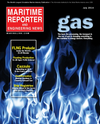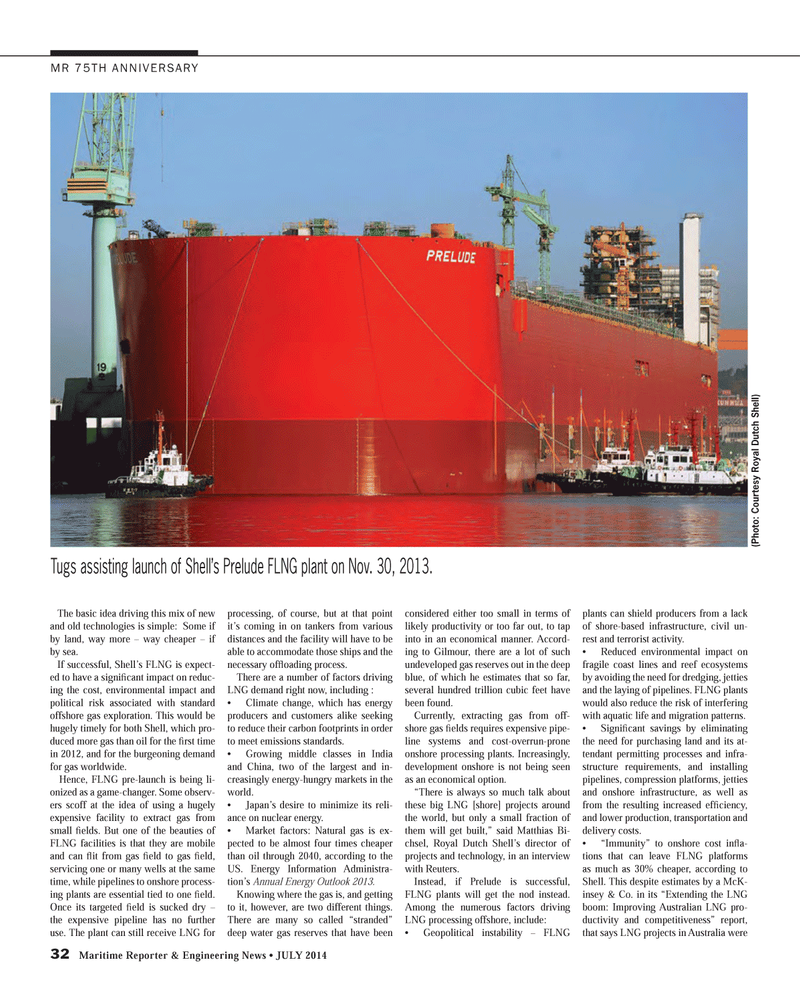
Page 32: of Maritime Reporter Magazine (July 2014)
Offshore Energy Structures & Systems
Read this page in Pdf, Flash or Html5 edition of July 2014 Maritime Reporter Magazine
32 Maritime Reporter & Engineering News • JULY 2014
Tugs assisting launch of Shell’s Prelude FLNG plant on Nov. 30, 2013.
The basic idea driving this mix of new and old technologies is simple: Some if by land, way more – way cheaper – if by sea.
If successful, Shell’s FLNG is expect- ed to have a signifi cant impact on reduc- ing the cost, environmental impact and political risk associated with standard offshore gas exploration. This would be hugely timely for both Shell, which pro- duced more gas than oil for the fi rst time in 2012, and for the burgeoning demand for gas worldwide.
Hence, FLNG pre-launch is being li- onized as a game-changer. Some observ- ers scoff at the idea of using a hugely expensive facility to extract gas from small fi elds. But one of the beauties of
FLNG facilities is that they are mobile and can fl it from gas fi eld to gas fi eld, servicing one or many wells at the same time, while pipelines to onshore process- ing plants are essential tied to one fi eld.
Once its targeted fi eld is sucked dry – the expensive pipeline has no further use. The plant can still receive LNG for processing, of course, but at that point it’s coming in on tankers from various distances and the facility will have to be able to accommodate those ships and the necessary offl oading process.
There are a number of factors driving
LNG demand right now, including : • Climate change, which has energy producers and customers alike seeking to reduce their carbon footprints in order to meet emissions standards. • Growing middle classes in India and China, two of the largest and in- creasingly energy-hungry markets in the world. • Japan’s desire to minimize its reli- ance on nuclear energy. • Market factors: Natural gas is ex- pected to be almost four times cheaper than oil through 2040, according to the
US. Energy Information Administra- tion’s Annual Energy Outlook 2013.
Knowing where the gas is, and getting to it, however, are two different things.
There are many so called “stranded” deep water gas reserves that have been considered either too small in terms of likely productivity or too far out, to tap into in an economical manner. Accord- ing to Gilmour, there are a lot of such undeveloped gas reserves out in the deep blue, of which he estimates that so far, several hundred trillion cubic feet have been found.
Currently, extracting gas from off- shore gas fi elds requires expensive pipe- line systems and cost-overrun-prone onshore processing plants. Increasingly, development onshore is not being seen as an economical option. “There is always so much talk about these big LNG [shore] projects around the world, but only a small fraction of them will get built,” said Matthias Bi- chsel, Royal Dutch Shell’s director of projects and technology, in an interview with Reuters.
Instead, if Prelude is successful,
FLNG plants will get the nod instead.
Among the numerous factors driving
LNG processing offshore, include: • Geopolitical instability – FLNG plants can shield producers from a lack of shore-based infrastructure, civil un- rest and terrorist activity. • Reduced environmental impact on fragile coast lines and reef ecosystems by avoiding the need for dredging, jetties and the laying of pipelines. FLNG plants would also reduce the risk of interfering with aquatic life and migration patterns. • Signifi cant savings by eliminating the need for purchasing land and its at- tendant permitting processes and infra- structure requirements, and installing pipelines, compression platforms, jetties and onshore infrastructure, as well as from the resulting increased effi ciency, and lower production, transportation and delivery costs. • “Immunity” to onshore cost infl a- tions that can leave FLNG platforms as much as 30% cheaper, according to
Shell. This despite estimates by a McK- insey & Co. in its “Extending the LNG boom: Improving Australian LNG pro- ductivity and competitiveness” report, that says LNG projects in Australia were
MR 75TH ANNIVERSARY (Photo: Cour tesy Royal Dutch Shell)
MR #7 (32-41).indd 32 7/1/2014 10:08:11 AM

 31
31

 33
33
